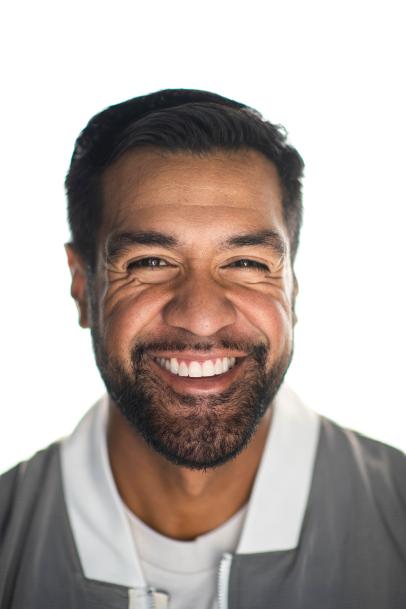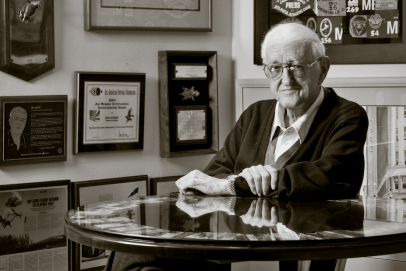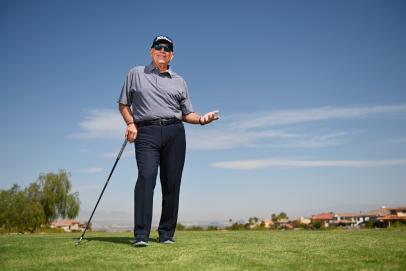Rap Report
Today’s elite players have a specialist for just about everything

Illustration by Asaf Hanuka
Collin Morikawa has a foot guy. No, seriously. The 25-year-old two-time major champion employs two trainers to design his fitness regimen—one of whom, Rian Chab, focuses on Morikawa’s feet. “If we relate it to the human gait cycle, the foot should pronate and supinate,” Chab says. “If it gets stuck in any of those positions, it can negatively impact how the body moves. It’s not to say that the feet are the problem, but if the feet are neglected, other swing adjustments you make above might not stick as well as they could.”
Welcome to the modern world of elite professional golf, which is more of a team experience than ever. The pro game has long been synonymous with rugged individualism, and it remains true that only one person hits the shots. But behind that name on the leader board sits a surprising number of collaborators, all working together in pursuit of the slightest edge. Cruise around a PGA Tour practice facility on a Tuesday, and you will see caddies, swing coaches, short-game coaches, putting coaches, mental-game coaches, equipment specialists, trainers, biomechanists, data analysts—and, yes, maybe even a foot guy.
Caddies are, of course, nothing new in professional golf. Nor are swing coaches, who have been fine-tuning the world’s best for decades. But players are now seeking guidance from experts across different fields—like Dr. Sasho MacKenzie, a professor in the department of human kinetics at St. Francis Xavier University in Canada, who has a Ph.D. in sports biomechanics. MacKenzie calls himself a “golf-score optimizer,” and he looks at the game through an analytical lens. Most of MacKenzie’s work involves educating swing coaches on the science behind the golf swing, though he does work with some players directly. One of those is U.S. Open champion Matthew Fitzpatrick. In conjunction with Fitzpatrick’s swing coach, Mike Walker, and with the assistance of data capturing technology and computer animations, MacKenzie helped Fitzpatrick gain 5 miles per hour of clubhead speed in about two years. “Clubhead speed is an equation,” MacKenzie says. “It’s a literal equation; the things the golfer does add up to clubhead speed. I can measure it.”
MacKenzie identified different ways for Fitzpatrick to increase the output of that equation without changing the feel of his swing. Increased grip pressure was one of them, so MacKenzie encouraged Fitzpatrick to practice hitting big, high draws. MacKenzie believed doing this would naturally help Fitzpatrick apply more “force” to the grip early in the swing. Once Fitzpatrick felt comfortable with that motion, MacKenzie instructed him to start releasing hard and to the left, a fade-like release that Fitzpatrick preferred. MacKenzie then filtered that information through Walker and had Fitzpatrick train with “The Stack,” MacKenzie’s speed-building system. The result has been about a 10-yard increase in driving distance.
“I’ll be honest,” Fitzpatrick says. “It’s worked wonders.”

Before winning the 2022 U.S. Open, Matt Fitzpatrick began working with Dr. Sasho MacKenzie, who has a Ph.D. in sports biomechanics, to help increase his clubhead speed. Their work, inconjunction with Fitzpatrick's swing coach, helped the Englishman gain 5 miles per hour of clubhead speed in about two years, resulting in about a 10-yard increase in driving distance.
Andrew Redington
Another doctor who is a member of multiple players’ teams is Dr. Bhrett McCabe, a clinical psychologist who works with Jon Rahm, Sam Burns, Billy Horschel and Davis Riley, to name a few. McCabe will sometimes walk with his players during practice rounds, but he prefers to do his work away from the golf course—say, in a coffee shop or a rental house.
“My job is to get them to believe in themselves more and to handle whatever comes their way,” McCabe says. “Confidence is not knowing you can do it. Confidence is knowing that you can face anything before you. Do you prepare the way you need to prepare? Or are you always fixing problems? Lastly, are you ready to go into the uncertainty of competition and get ready to brawl when pressure picks up? If I can get them to believe in themselves to do that, we’re 99 percent of the way there.”
Whereas players of the past relied mostly on instincts, today’s stars turn to data experts.
Part of that belief comes from trust in your clubs. Every player on tour, even those without an endorsement deal, will interact with equipment reps throughout the season. These reps are in charge of making sure every piece of equipment is dialed in on any particular week. Kenton Oates, a tour representative for Ping, will attend 35 to 38 tournaments a year.
“We’re checking in with players on Sunday or Monday, whenever they get to the golf tournament, making sure that they don’t need grips and that their clubs are all good,” Oates says. “Do you need a fresh lob wedge? How’s your gear? Is your driver good? We’re basically a NASCAR pit crew trying to make sure all their gear is ready to go.”
Once they get their body right, their mind primed and their equipment prepped, the players shift to on-course strategy. Whereas pros of bygone eras would rely on instincts and experience, today’s stars turn to statistics experts who create customized instructions for each of their players, the details of which depend on their strengths, weaknesses and the golf course. These stat gurus will also craft detailed practice plans for players with an emphasis on improving specific parts of their games.
Hunter Stewart isn’t an average stats guy. He played collegiate golf at powerhouse Vanderbilt and was on the 2015 Walker Cup team. After a brief pro career, he dived into the data world and convinced two pros, Maverick McNealy and Robby Shelton, to let him help them. He now works with seven players on the PGA Tour.
“Every player has different strengths,” Stewart says. “Some of them are going to hit drivers on certain holes that others aren’t. You’re not going to see my guys playing to the exact same spot. If you’ve got one player that’s a bad iron player and one that’s one of the best at it, and then you’ve got another guy who’s not a great driver and one who is, you’re going to see a bunch of different strategies.”
For the player, who McCabe calls “the tip of the spear,” a bunch of team members means a bunch of checks to cut. It’s not uncommon for an elite player to pay out as much as $1 million or more annually to his entourage. (Most of these collaborators are paid a flat fee, plus a percentage of on-course winnings.) I asked Morikawa if he winces at the idea of slicing a tournament check into so many different pieces. His response speaks to the mind-set of players in 2022, when professional golf is big business.
“When it comes down to it, it’s all an investment on this business, this brand that we’re building,” Morikawa says. “So whether I need to pay for this person’s flights or for helping me work out a little more, it’s all an investment for me to get better and perform as best as I can. It’s not tough to write these checks because I’m trying to improve myself, and all these people around me are trying to do the same.”




